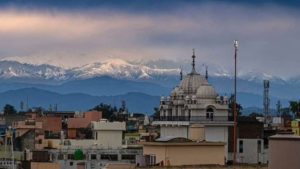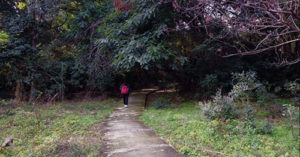
Dhauladhar range in Himachal Pradesh (HP) is visible from Jhalandar
During the coronavirus pandemic, as human beings across the world have retreated into their homes, the rest of nature has breathed a collective sigh of relief and enjoyed something of a renaissance. This was neatly encapsulated by the reports from Punjab that, as air pollution cleared, the residents of Jalandhar could see the Dhauladhar range 200km away in Himachal Pradesh for the first time in living memory. Various other stories have documented improved water quality in the canals of Venice, reduced nitrogen dioxide in the skies over China, and increased wild animal populations in abandoned urban spaces.
Mother Earth’s reprieve, however, is likely to only be temporary if humanity returns to business as usual when this pandemic passes. In his Earth Day message on April 22, His Holiness the Dalai Lama spoke of the virus as “Our mother earth teaching us a lesson in universal responsibility.” In his statement to mark the day, United Nations Secretary General Antonio Guterres said that despite the impacts of the coronavirus pandemic, the world must not forget the “deeper environmental emergency” facing the planet.

Photo: Tenzin Samten/Contact
The ties between environmental degradation and virus outbreaks have long been known. In nature, everything is about interactions. Forests consist of complex feedback relations between trees, fungi and bacteria. Butterflies exist because of interactions between plants, animals, fungi and protozoa. Life exists in symbiosis. According to Andrew Norton, Director of the International Institute for Environment and Development, land-use change and deforestation are interacting to destroy global biodiversity and heighten “the risk of further pandemics by bringing humans into contact with new threats such as the coronavirus.” Dr Karen O’Neill of Rutgers University in the United States says that “degraded environments and pollution make us more likely to encounter novel viruses and to be more vulnerable to those viruses when they start to circulate.”
Kristian Andersen, the leader of a study published in the journal Nature Medicine which found no evidence that the coronavirus was made in a laboratory, said that from “the analysis of public genome sequence data…we can firmly determine that SARS-CoV-2 originated through natural processes.” But the conditions in a wet market in Wuhan or a factory farm in the United States are far from natural, they are ecological timebombs with consequences that are now all too clear.
 Farmed animals are forced to live in severely cramped conditions and viruses can spread quickly between species in an environment like the wet market in Wuhan, China. These conditions are replicated in farming practices across the world. In 2011, more than 80% of the world’s antibiotics were fed to livestock, mostly for the sake of artificially increasing rapid growth to satisfy consumer demand for meat. This practice contributes to the rise of deadly super bugs in the animals that are resistant to antibiotics. A 2014 study found that 65% of pigs farmed in the US had “pneumonia like lesions on their lungs” due to the pigs coming into contact with ammonia and other gases released from the manure they live on.
Farmed animals are forced to live in severely cramped conditions and viruses can spread quickly between species in an environment like the wet market in Wuhan, China. These conditions are replicated in farming practices across the world. In 2011, more than 80% of the world’s antibiotics were fed to livestock, mostly for the sake of artificially increasing rapid growth to satisfy consumer demand for meat. This practice contributes to the rise of deadly super bugs in the animals that are resistant to antibiotics. A 2014 study found that 65% of pigs farmed in the US had “pneumonia like lesions on their lungs” due to the pigs coming into contact with ammonia and other gases released from the manure they live on.
 In 1993 His Holiness published The Sheltering Tree of Interdependence, a poem composed to “call upon all concerned people to reverse and remedy the degradation of our environment.” One of the stanzas is particularly relevant today, as billions of people across the globe shelter from an invisible threat:
In 1993 His Holiness published The Sheltering Tree of Interdependence, a poem composed to “call upon all concerned people to reverse and remedy the degradation of our environment.” One of the stanzas is particularly relevant today, as billions of people across the globe shelter from an invisible threat:
4. Lakes and ponds have lost
Their clarity, their coolness
The atmosphere is poisoned
Nature’s celestial canopy in the fiery firmament
Has burst asunder
And sentient beings suffer diseases
Unknown before.
Despite this connection between environmental degradation and the outbreak of infectious diseases, media outlets have rarely focused on this in their efforts to report on the coronavirus crisis. Sensationalist narratives, which include the virus being manufactured in a laboratory and purposefully deployed as a biological weapon, gain traction whilst rational scientific explanations are often not given the same coverage. The idea that the coronavirus represents a climate change warning is uncomfortable to many, but it is now becoming clear that systemic change in the way that the human race interacts with the nature that sustains it is the only way to ensure that global lockdowns in response to new virus outbreaks do not become the new normal of the 21st century.
Concluding The sheltering tree… His Holiness wrote:
28. Being attentive to the nature
Of interdependence of all creatures
Both animate and inanimate
One should never slacken in one’s efforts
To preserve and conserve nature’s energy
29. On a certain day, month and year One should observe the ceremony
Of tree planting
Thus, one fulfills one’s responsibilities
Serves one’s fellow beings
Which not only brings one happiness
But benefits all
30. May the force of observing that which is right
And abstinence from wrong practices and evil deeds
Nourish and augment the prosperity of the world,
May it invigorate living beings and help them blossom
May sylvan joy and pristine happiness
Ever increase, ever spread and encompass all that is.




 Print
Print Email
Email